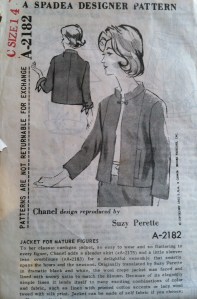Hi everyone! Just a heads up that part two of my interview with Susan Khalje, where she spills the secrets of “The Little French Jacket” (AKA making a Chanel Jacket, cardigan jacket etc.) has been posted on WeAllSew.com, and you can find it by clicking here. When I spoke to her, she gave me the history of this enduring design, and explained how the famous three-part sleeve is fantastic for fitting.
Aren’t those jackets she made beautiful? Her online “French Jacket” course has just launched, and I’m eager to take a look at it! You can find the info on SusanKhalje.com.
As for my sewing, hm, the end of my son’s school year kind of did that in. But now that I’m back in my island summer sewing shed, I’m going to get right on it. Just as soon as…
Somebody, GET THAT MAN OUT OF HERE! (Just because I can run a high-tech machine doesn’t mean I know how to fix the printer for you, hon…)
During the winter, I had fun making up some classic Issey Miyake Vogue patterns. The construction was so fascinating! Even though, technically, patterns from the early 2000s aren’t “vintage,” these designs definitely fit under the “modernist” umbrella, which starts with Vionnet and continues through Claire McCardell and Halston.
When I looked up info on Issey Miyake’s theories of design, which include using technically advanced fabrics and manufacturing techniques, I found that trying to pin down his Japanese philosophy and express it in English was beyond my cross-cultural capabilities. So here’s the bio from his official website: Issey Miyake Bio
I decided to make up two of his patterns as part of the PatternReview.com Travel Wardrobe contest, which was loads of fun. I was short on time, so I wanted to make things that required only one or two pattern pieces.
My first make was from this pattern, Vogue 2814:
The sleeveless top on the right was intriguing, because the pattern was cut as all one piece!
That’s it, you’re looking at it. I cut it out from some light cotton/lycra jersey in my stash, and proceeded to scratch my head over the instructions. (I don’t envy the people who had to write up the guide sheet at Vogue.)
In lieu of top-stitching the edges (but leaving them raw, as called for in the pattern), I used a kind of 50s-looking Greek Key decorative stitch to finish the edges with a little stretch.
After a number of twists and turns, and more head-scratching, I ended up marking the center front, left and right sides etc. with chalk so I could figure it all out.
Lo and behold, the pinwheel became a nice summer top with a twist!
It only took a few hours start to finish, which has got to be a new record for me. Here’s the play-by-play on Pattern Review.
Then I decided to go for a Miyake skirt, from Vogue 2437. (Alas, I don’t have a photo of the pattern at present, but if you go to my review on Pattern Review Vogue 2437, it should turn up.)
This skirt is also cut from one pattern piece, and here I’m using Eileen Fisher rayon ponte, which has a nice drape.
Just a big rectangle-ish piece, right? Not so fast. There are so many weird darts and closures that I used white tracing paper and a tracing wheel to mark them, followed by chalk.
See what I mean? Yes, those are overlapping darts.
The only closures on this skirt are two rows of snap tape. The idea is that you can snap it how you want to give it variations in the drape. I had some brass snap tape from Paris that did the trick.
Upon giving the skirt a test drive, though, I discovered that the snap tape did not have enough hold for my middle-aged behind, so I added a giant snap at the top.
Voila!
It’s a hard to photograph, but it’s a really fun design. I used Steam-a-Seam Lite 2 to secure the edges and snap tape before top-stitching, which helped a lot.
Here’s one way that I “styled” the two pieces for the contest.
(You may recall that I made that quilted Chanel bag “homage” last year, and the info on that is in this post.)
I really recommend the Miyake patterns from this era!
In other news, last June I announced that BERNINA of America was loaning me a B560 for a year, and, of course, my on-going love affair with my “Swiss Intern Karl” has been fodder for the tabloids ever since. I’m happy to let you know the good news that Karl has signed on for another couple of semesters here at JetSetSewing.com! Which is great because I don’t know what I would do without his fabulous feed and New Wave yodeling. My thanks again to Bernina of America for their generosity. Details can be found by clicking the “Bernina Collaboration” tab above.
Do you think Karl is sticking around because he’s jealous of this new member of the Jet Set Sewing team?
Well hello, sweet little Carline! Fresh off the Ebay assembly line. She’s gotta be 50-something, and yet this little Minimatic can still satin-stitch like a champ. (I did my research before I bid, because the cam gears on these girls can crack after all of this time. This one had an overhaul by a collector.) 25 pounds of fun in her own little suitcase!
Hope your sewing’s going well!




















